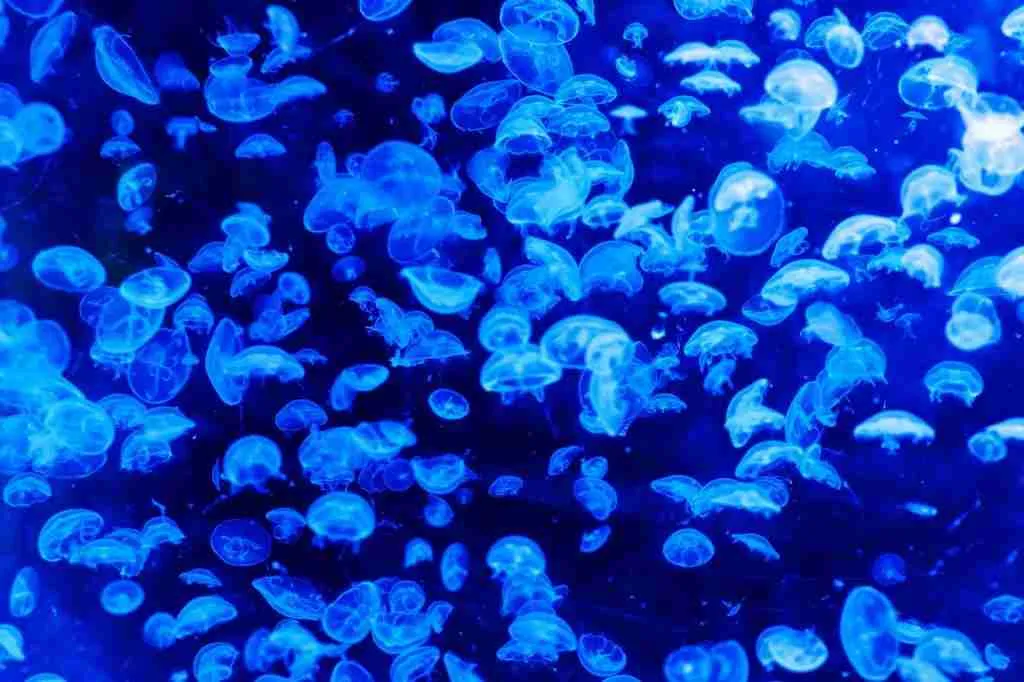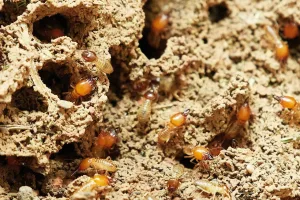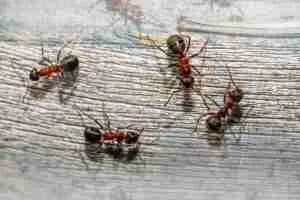25 Fun Facts About Jellyfish You Need to Know
-
Jellyfish have no bones, blood, or brain, but they can still move and hunt for food.
-
Some jellyfish species have been found in both freshwater and marine environments.
-
Their reproductive cycle includes both a medusa (adult) and polyp (larval) stage.
-
The longest-lived jellyfish species can live up to 4 years.
-
Some species can reproduce asexually, creating clones of themselves.
-
Jellyfish thrive in warmer ocean waters but can also survive in colder waters.
-
The smallest jellyfish can fit through the eye of a needle.
-
Jellyfish have been observed to use their stingers as a defense against predators.
-
Jellyfish have been living on Earth for more than half a billion years.
-
Some jellyfish, like the lion’s mane, have tentacles longer than a blue whale.
-
They can reproduce sexually and asexually, depending on environmental factors.
-
The box jellyfish has eyes that can see in four different directions.
-
Some jellyfish can pulsate their bodies to move faster when escaping predators.
-
Jellyfish possess a “mouth” located on the underside of their bell.
-
Jellyfish can be used to test the toxicity of substances in water due to their sensitivity.
Table of Contents
1. Over 600 million years old, jellyfish are ancient creatures.
Jellyfish have existed long before dinosaurs, trees, or even fungi. They are the oldest multi-organ animals, surviving all five of Earth’s mass extinction events.
This includes the Great Dying, also known as the Permian-Triassic extinction event, which wiped out 70% of life on our planet. They have adapted through millions of years of evolutionary change.
2. Jellyfish can reproduce both sexually and asexually.
Did you know that fun facts about jellyfish include the fact that their reproduction occurs sexually by releasing sperm and eggs into the water? The eggs then hatch into larval jellyfish, which take several months to mature into adults.
Asexual reproduction involves a process known as fission in which adult jellyfish splits into two or smaller individuals.
3. Made up of 95% water, they are mostly liquid.
Jellyfish are primarily composed of water, with their bodies made up of about 95% liquid. This makes them appear translucent and delicate in the water.
This high water content also contributes to their lightweight bodies, which helps them float effortlessly through the ocean.
4. Without brains, hearts, or lungs, their simplicity is astonishing.
Jellyfish are incredibly simple creatures, lacking brains, hearts, and lungs. Their bodies are made up of just three basic layers.
Despite their simplicity, jellyfish have survived millions of years and are a successful species in the ocean.
READ ALSO: 17 Fun Facts About Owls You Didn’t Know
5. Glow in the dark thanks to bioluminescence.
Many jellyfish species have bioluminescent organs that allow them to glow in the dark. This glowing feature is often blue or green.
This bioluminescence helps jellyfish in various ways, such as attracting prey or startling predators in the deep ocean.
6. They have 24 eyes, despite having no brain.
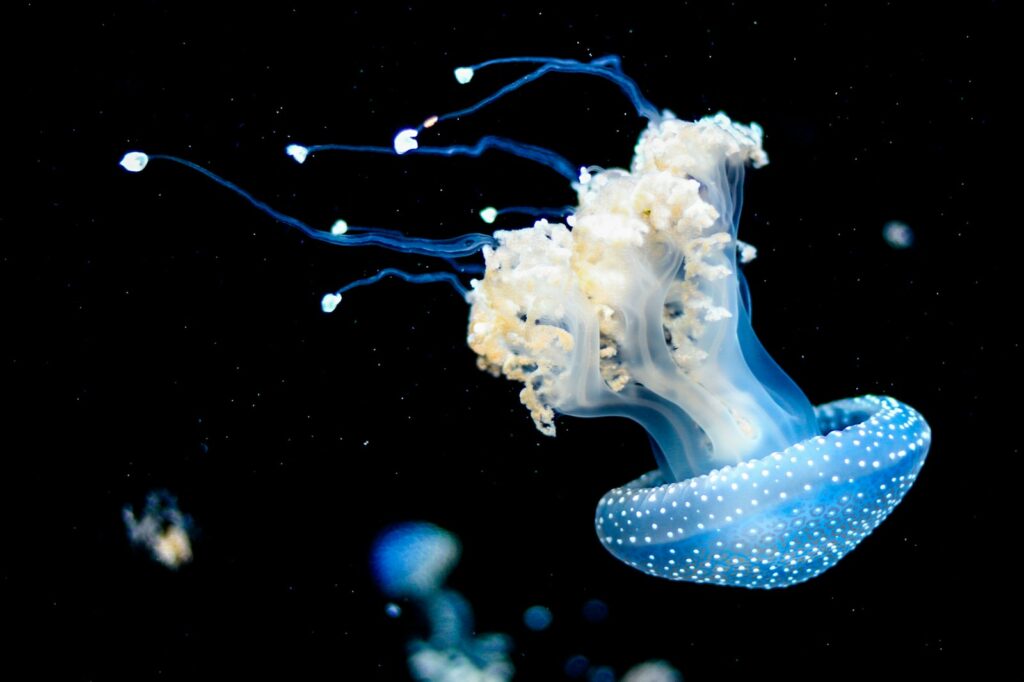
Some jellyfish species, such as the box jellyfish, have 24 eyes despite not having a brain. Two of these eyes are capable of seeing color.
These eyes give jellyfish a unique ability to detect their surroundings and potentially avoid threats in their environment.
7. Some species are biologically immortal.
The “immortal jellyfish” (Turritopsis dohrnii) has the unique ability to revert its cells back to earlier stages of life. This process allows it to start its life cycle over again.
As a result, these jellyfish could theoretically live forever, making them a fascinating subject of scientific study.
8. In some cultures, jellyfish are a delicacy.
In countries like China, Japan, and Korea, jellyfish are considered a delicacy. They are often dried and used in various culinary dishes.
Jellyfish are valued for their unique texture and low-calorie content, making them a popular ingredient in salads and soups.
READ ALSO: 25 Fun Facts About Swans That Will Blow Your Mind
9. Freshwater lakes also host jellyfish.
Though jellyfish are typically marine creatures, some species, like Craspedacusta sowerbii, live in freshwater lakes. These species are much smaller compared to their ocean-dwelling relatives.
This ability to survive in freshwater environments expands the range of jellyfish beyond the seas and into rivers, lakes, and ponds.
10. Large blooms are a phenomenon with jellyfish.
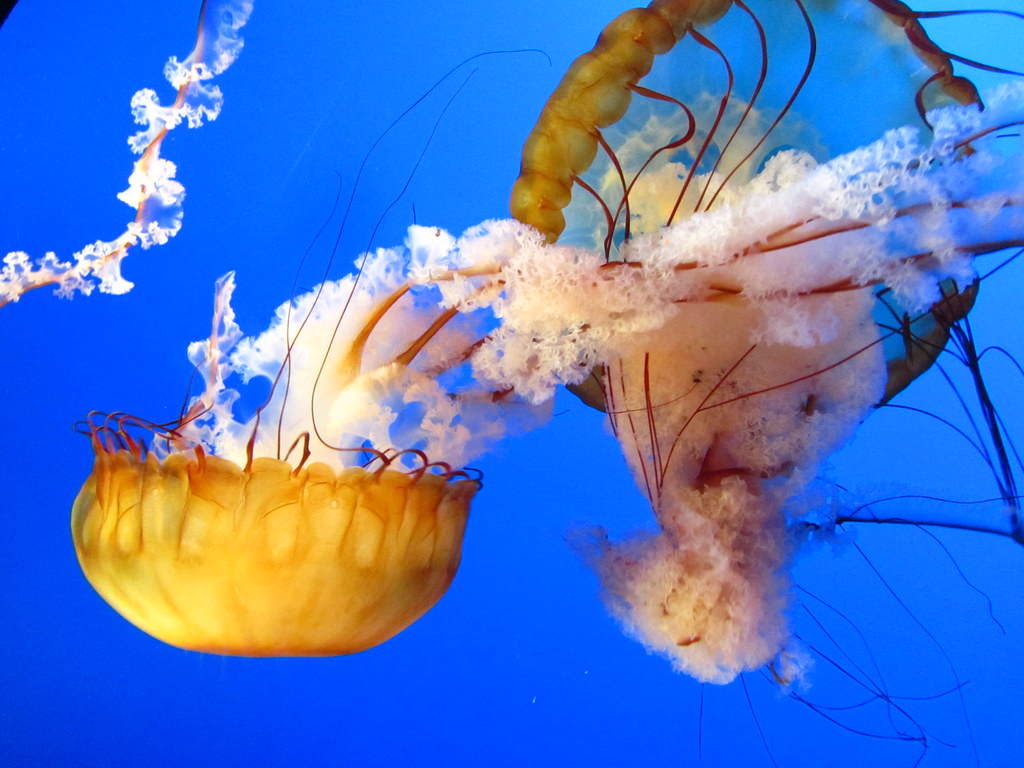
Jellyfish are known to form large blooms or clusters, especially under favorable environmental conditions. These blooms can be made up of millions of jellyfish.
Jellyfish blooms can sometimes cause ecological problems, like clogging fishing nets and disrupting local marine life.
11. They’re used in scientific research.
Jellyfish play an important role in scientific research, especially in studies related to bioluminescence. The green fluorescent protein from jellyfish is used in molecular biology.
This protein has been instrumental in genetic studies and the development of fluorescent markers for lab experiments.
12. Jellyfish can be dangerous to humans.
While not all jellyfish are dangerous, some species have potent venom that can harm humans. Box jellyfish, for instance, are one of the most venomous creatures on Earth.
Their tentacles contain thousands of stinging cells, capable of delivering a painful and sometimes fatal sting.
13. The oldest multicellular organisms on the earth are jellyfish.
Fossils of jellyfish have been discovered dating back to 545 million years ago. The history of jellyfish may date back to 700 million years.
If this is the case, then the jellyfish are three times as old as giant dinosaurs which once roamed across the earth. However, due to the absence of bones, it is difficult to find the fossils of jellyfish.
14. They can be found in a wide array of colors.
Jellyfish come in various colors, such as yellow, blue, orange, and brown. Their translucent bodies often glow, adding to their striking appearance.
Some species can reflect light in such a way that they appear to shimmer in the water, creating a mesmerizing effect for anyone observing them.
15. They thrive in a variety of habitats.
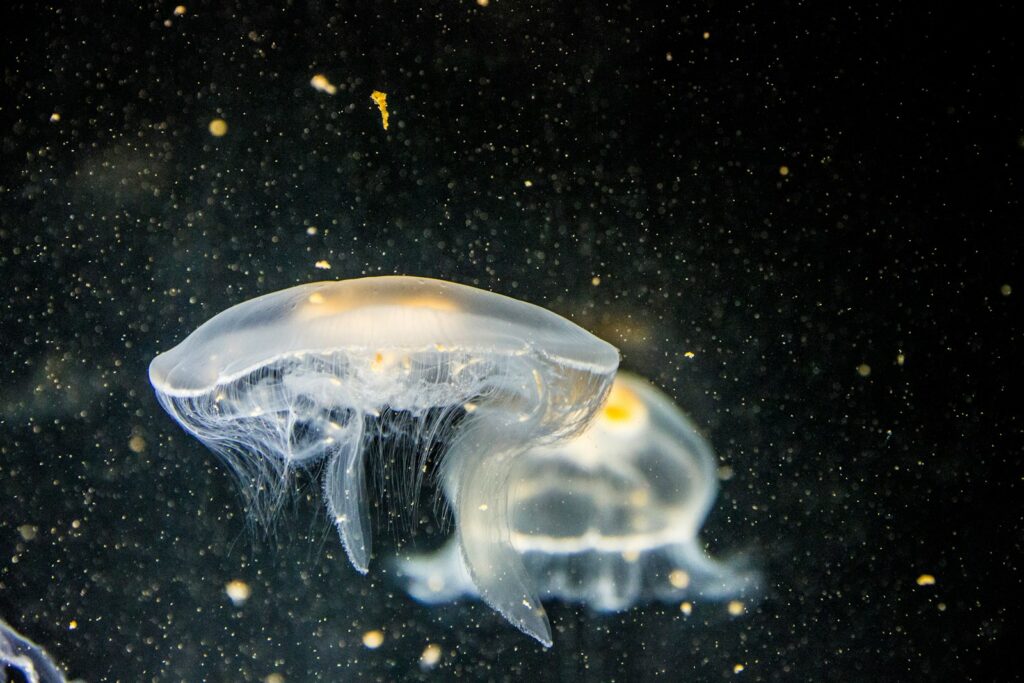
READ ALSO: 10 Amazing Facts About Sea Animals | Deep-Sea Mysteries
Jellyfish can be found in a range of habitats, from coastal regions to the open ocean, and even freshwater lakes. Their adaptability allows them to survive in many different conditions.
This widespread presence across diverse environments speaks to their resilience and success as a species.
16. Jellyfish have been used in traditional medicine.
In some cultures, jellyfish have been used in traditional medicine. They are believed to help with conditions such as muscle pain and inflammation.
In China, for example, jellyfish are sometimes included in health remedies, showcasing their role in ancient healing practices.
17. Their bodies come in many unique forms.
Jellyfish exhibit a variety of body shapes, from the dome-like bell shape of moon jellyfish to the long, trailing tentacles of the lion’s mane.
Each species has evolved its own body structure, which helps it adapt to specific marine conditions, whether it’s to catch food or avoid predators.
18. Thriving in both warm and cold oceans.
Jellyfish are capable of thriving in both warm tropical seas and cold waters of the Arctic. This adaptability has allowed them to spread across all the world’s oceans.
Whether in warm or cold waters, jellyfish continue to thrive due to their ability to regulate their own body temperatures and stay buoyant.
19. They’re essential in marine biology studies.
Jellyfish are key subjects in marine biology research. Their simple body structure makes them perfect for studying basic biological processes.
Research into jellyfish has led to significant discoveries about regeneration, cellular growth, and other areas of biology.
20. Tentacles are used for capturing food.
Jellyfish use their long, tentacle-like appendages to capture prey. These tentacles are lined with stinging cells that paralyze the prey.
Once the prey is immobilized, the jellyfish brings it to its mouth for digestion, relying on its tentacles to capture food efficiently.
21. There are over 2,000 known species of jellyfish found in oceans all around the world!
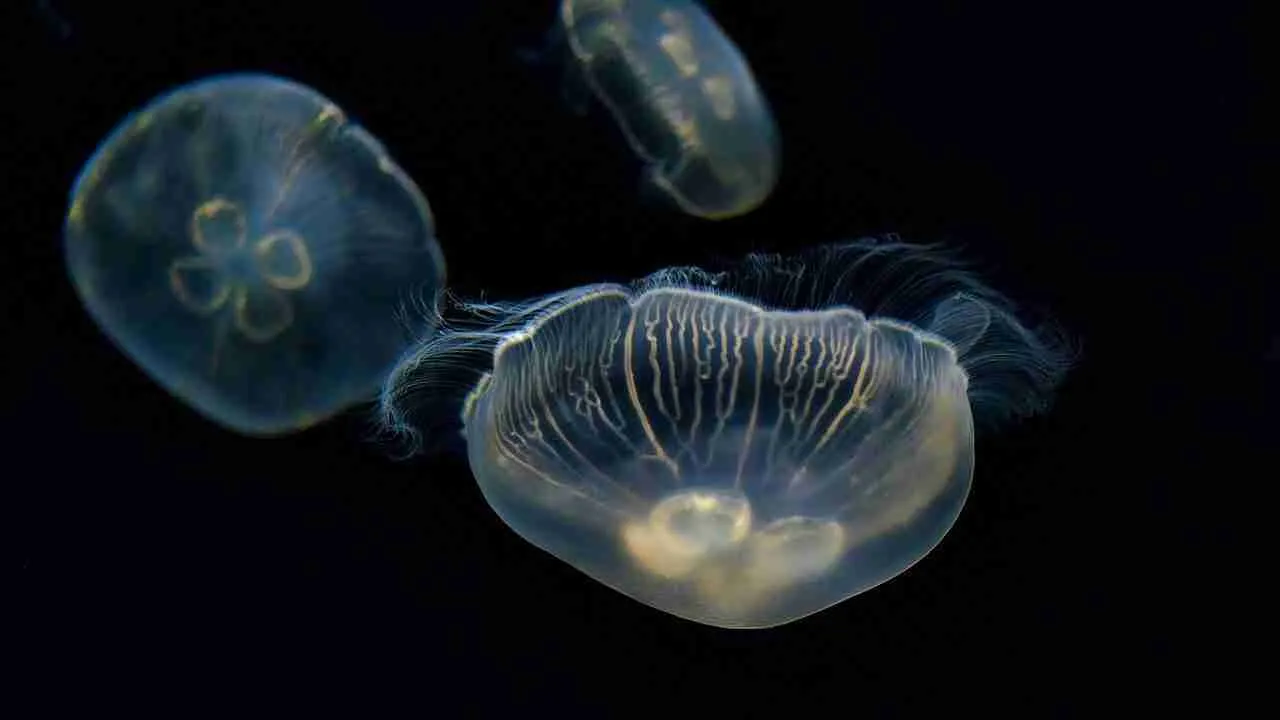
inhabit oceans worldwide!
Fun facts about jellyfish abound! With more than 2,000 types, jellyfish span oceans everywhere. From deep ocean depths to lagoons, coral reefs, and seas, there seems to be no end to the places jellyfish are found.
The term “jellyfish” comes from their jello-like appearance when seen from above.
READ ALSO: 23 Facts About Ants (Tiny Ants with Mighty Facts)
22. Some species can regenerate lost body parts.
Certain species of jellyfish have the ability to regenerate lost body parts, including tentacles and parts of their central bell. This regenerative process is quite remarkable.
Studying jellyfish regeneration can provide valuable insights into cellular biology and potential applications in human medicine.
23. Lifespans vary widely across species.
Jellyfish lifespans can vary greatly depending on the species. While some live for only a few weeks, others can live for several years or even regenerate indefinitely.
Some jellyfish, like the immortal jellyfish, can live forever by reverting to an earlier stage in their lifecycle.
24. Some jellyfish species can “fly” through the water.
Some jellyfish, like the Portuguese man o’ war, can move more rapidly through the water by expanding and contracting their bodies, creating a form of propulsion.
While they don’t “fly” like birds, their ability to glide on the surface of the water allows them to cover large distances efficiently.
25. Some jellyfish species can form symbiotic relationships.
Some species of jellyfish have symbiotic relationships with other marine organisms, like algae. These algae live within the jellyfish’s tissues and provide it with energy through photosynthesis.
In return, the algae get a safe environment to grow in, demonstrating the complex interactions in marine life.
READ ALSO: 25 Facts About Dogs You Never Knew
FAQs
Jellyfish stings can be deadly, with species like the box jellyfish possessing venom powerful enough to cause heart failure. Some jellyfish are known to disrupt entire marine ecosystems by overwhelming fish populations. The “immortal jellyfish” can potentially live forever, but its ability to regenerate also highlights the darker, strange side of their biology. Additionally, jellyfish blooms are increasing, possibly due to climate change, affecting local fisheries and marine life.
Jellyfish are unique due to their simple anatomy with no brain, heart, or bones, yet they can survive for millions of years. Their bioluminescence, regenerative abilities, and remarkable adaptation to both freshwater and marine environments make them fascinating. They also have a unique life cycle with both sexual and asexual reproduction phases, showing their ability to adapt in diverse conditions.
The number of tentacles varies widely depending on the species. Some jellyfish have as few as four tentacles, while others, like the lion’s mane jellyfish, can have up to 120 long tentacles. These tentacles are lined with stinging cells that help them capture prey and defend against predators.
Jellyfish primarily eat plankton, small fish, and other microscopic creatures, which they capture using their tentacles. Their tentacles contain specialized cells called nematocysts that inject venom to paralyze or kill their prey. Once immobilized, the jellyfish brings the prey to its mouth for digestion.

